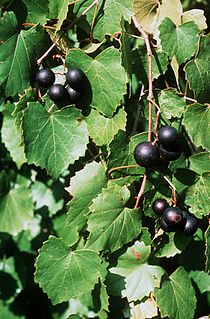
Vitis rotundifolia, or muscadine, is a grapevine species native to the southeastern and south-central United States. The growth range extends from Florida to New Jersey coast, and west to eastern Texas and Oklahoma. It has been extensively cultivated since the 16th century. The plants are well-adapted to their native warm and humid climate; they need fewer chilling hours than better known varieties, and thrive in summer heat.

Vitis riparia Michx, with common names riverbank grape or frost grape, is a vine indigenous to North America. As a climbing or trailing vine, it is widely distributed across central and eastern Canada and the central and northeastern parts of the United States, from Quebec to Texas, and eastern Montana to Nova Scotia. There are reports of isolated populations in the northwestern USA, but these are probably naturalized. It is long-lived and capable of reaching into the upper canopy of the tallest trees. It produces dark fruit that are appealing to both birds and people, and has been used extensively in commercial viticulture as grafted rootstock and in hybrid grape breeding programs.

Vitis mustangensis, commonly known as the mustang grape, is a species of grape that is native to the southern United States. Its range includes parts of Mississippi, Alabama, Louisiana, Texas, and Oklahoma.

Apocynoideae is a subfamily of the flowering plant family Apocynaceae. It contains about 78 genera with roughly 860 species. Several genera are of pharmacological interest - notably those - such as Strophanthus - which have furnished highly effective arrow poisons, due to their cardiac glycoside content. The subfamily includes many species with flowers of considerable ornamental value, the best-known of which is Nerium oleander, the familiar Oleander. It also contains the remarkable pachycaul genera Adenium and Pachypodium.
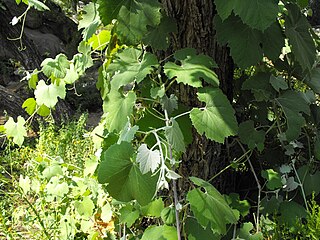
Vitis girdiana is as species of wild grape known as the desert wild grape and valley grape. It is native to southern California in the United States and to Baja California in Mexico.

Vitis (grapevines) is a genus of 79 accepted species of vining plants in the flowering plant family Vitaceae. The genus is made up of species predominantly from the Northern hemisphere. It is economically important as the source of grapes, both for direct consumption of the fruit and for fermentation to produce wine. The study and cultivation of grapevines is called viticulture.
Artocarpus blancoi is a species of plant in the family Moraceae endemic to the Philippines. Its habitat is threatened.
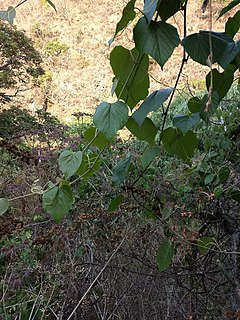
Vitis tiliifolia is a New World liana in the grape family commonly known as Caribbean grape. Other names include West Indian grape, water vine, and water tie-tie and water-wise.
Vitis adenoclada is a species of plant in the grape family. It is found in the province of Hunan in China, where the climate is temperate.

Vitis shuttleworthii is a North American liana in the grape family commonly known as the calloose grape or bear grape. The name refers to the group of Native American people that resided in southwest FL, the Calusa. It is native to south and central Florida, with isolated populations in southern Alabama.
Vitis balansana is a species of climbing vine in the grape family native to temperate and tropical Asia. Its native range encompasses Vietnam and three southeastern provinces in China The habitat of V. balansana varies; it has adapted to living under forest cover, and in sun-soaked shrubland valleys, at between 200–800 meters.
Vitis nesbittiana is a species of liana in the grape family. It is native to central Mexico (Veracruz).
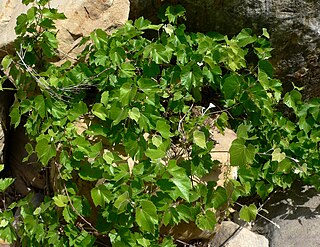
Vitis arizonica is a North American species of wild grape. It is a deciduous vine.

Vitis flexuosa is a species of liana in the grape family.
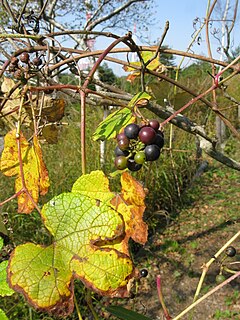
Vitis ficifolia is a species of liana in the grape family native to the Asian temperate climate zone. It is found in mainland China, Japan, Taiwan and the Koreas.
Vitis tsoii is a species of wild grape in the family Vitaceae. It is native to the provinces of Fujian, Guangdong, and Guangxi in China, where the climate is temperate.
Vitis monticola, commonly known as mountain grape, or sweet mountain grape, is a North American species of wild grape native to Texas. It is important to grape growers for its resistance to drought; a quality exploited both genetically in hybridization, and in grafting.
Vitis jaegeriana is a plant species in the grape family that is endemic to North-Central Mexico.
Vitis xunyangensis is an Old World species of wild grape native to temperate China.
Vitis popenoei, commonly called the totoloche, or totoloche grape, is a New World species of liana in the grape family native to Belize, Mexico, and north-central Guatemala.










